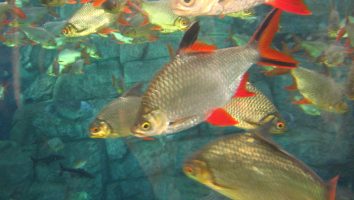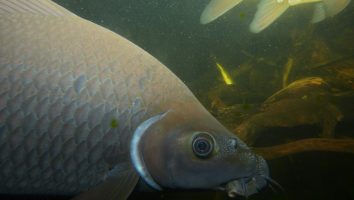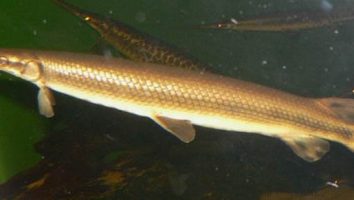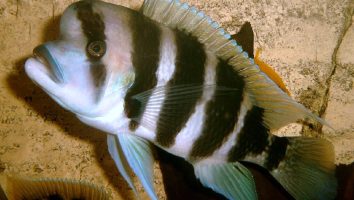The yellow dwarf cichlid is a beautiful and popular freshwater fish that is perfect for beginner aquarium hobbyists. This species is relatively easy to care for and can thrive in a wide range of water conditions.
Table of contents
Species overview
The yellow dwarf cichlid (scientific name: Apistogramma nijsseni) is a freshwater fish that’s native to the Amazon Basin.
They are found in a wide variety of habitats but prefer slow-moving waters with a lot of vegetation. This is something that’s common among many species of cichlid.
Yellow dwarf cichlids are very peaceful fish and can be kept with a wide variety of other fish species. They are also very easy to care for, which makes them a great choice for beginner aquarium hobbyists.
One of the most notable things about this fish is its bright yellow color. This is what gives it its common name and is one of the main reasons why it’s so popular among aquarium enthusiasts.
Appearance

The first thing you’ll notice about the yellow dwarf cichlid is their color. As their name suggests, these fish are a beautiful lemon yellow all over their bodies.
This color is solid from head to toe with a few variations depending on the fish. Some individuals may have a few black spots on their dorsal fin or their caudal peduncle.
The second thing you’ll notice is their long and thin body shape. These fish are quite tall and thin, which gives them a very streamlined appearance.
The dorsal fin on the yellow dwarf cichlid is large and triangular. It starts about two-thirds of the way back on their body and extends all the way to the tail.
The anal fin is a bit smaller but matches the dorsal fin in both shape and placement.
The caudal fin is fairly large and forked. It’s slightly asymmetrical with the top being a bit longer than the bottom.
The pectoral fins are small and thin. They’re located close to the head of the fish.
The ventral fins are also small and thin. They’re located about halfway down the body of the fish.
Lifespan
The yellow dwarf cichlid has a lifespan of around 5-8 years. Of course, this number will differ based on the individual fish and the environment they’re living in.
If you take excellent care of your yellow dwarf cichlid and provide them with everything they need, they could potentially live up to 10 years.
Size
Depending on the species, yellow dwarf cichlids range in size from 2.5 to 5 inches. The vast majority of them will max out at 4 inches, though.
Tank
Tank Size
The recommended tank size for a single yellow dwarf cichlid is 20 gallons. If you want to keep more than one yellow dwarf cichlid in the same tank then you should add 10 gallons for each additional fish.
You might be able to get away with a smaller tank if you have a very well-planted aquarium with hiding spots for your fish. These fish like to have a lot of places to hide so they feel safe and secure in their environment.
Water Parameters
The yellow dwarf cichlid is a freshwater fish that is native to Africa. In the wild, they are found in slow-moving rivers and streams with plenty of vegetation.
This is a small cichlid, only reaching about 2.5 inches at full adult size. They are a peaceful species that does well in a community tank.
When it comes to their water parameters, they prefer slightly acidic water that is on the soft side.
- Water temperature: 72 to 82 degrees Fahrenheit
- pH levels: 6.0 to 7.8
- Water hardness: 2 to 12 dGH
- Alkalinity Levels: 4-8 dKH
What To Put In Their Tank
When it comes to setting up an aquarium for Yellow Dwarf Cichlids the sky is the limit. These fish are very adaptable and can make do in a wide range of conditions.
With that being said, we still recommend taking the time to set up their habitat in a way that will be comfortable for them.
The substrate is one of the most important things to consider. Yellow Dwarf Cichlids are known to be quite the diggers. They love to sift through the substrate in search of food.
For this reason, we recommend using a softer substrate like sand. This will be more comfortable for them and prevent any cuts or scrapes that could be caused by a harder substrate.
As for decorations, it’s really up to you. These fish aren’t very picky and will do well in a wide range of conditions.
We recommend adding some plants, driftwood, and rocks to their tank. This will help create a more naturalistic environment for them to live in.
Just make sure that any rocks or driftwood you add are securely in place. These fish are known to be quite active and could easily uproot or damage things that aren’t properly secured.
Common Diseases
In terms of Yellow Dwarf Cichlid care, there are a few things you’ll need to be aware of.
First and foremost, these fish are pretty Hardy. They’re not as susceptible to disease as some other freshwater species.
That being said, they can still get sick if the water conditions in their tank are poor. The most common illness you’ll need to watch out for is ich.
This is a parasites that can cause a lot of problems for your fish if it’s not treated quickly. The most obvious symptom is the presence of white spots on the body, fins, and gills of your fish.
If you notice this, it’s important to act fast. There are a lot of different ways to treat ich, but the sooner you start the treatment the better.
Another thing you’ll want to keep an eye out for is hole-in-the-head disease. This is another water quality-related illness that’s pretty common in cichlids.
It’s characterized by one or two pits/holes in the skin of your fish’s head. While it’s not usually fatal, it can be pretty unsightly.
The best way to prevent your Yellow Dwarf Cichlid from getting sick is to maintain a clean and stable tank. This will go a long way in keeping your fish healthy and happy.
Behavior & Temperament
The yellow dwarf cichlid is a peaceful and relatively shy fish. It’s not the most active fish in the world, but it does like to move around and explore its territory.
These fish are known to be pretty good parents. The females will lay their eggs in a cave or crevice, and the males will guard them until they hatch. Once the fry are free-swimming, the parents will still protect them until they’re big enough to fend for themselves.
While the yellow dwarf cichlid is peaceful, it is still a cichlid. That means it can be territorial and may not do well with other cichlids. It’s best to keep them with fish of similar size and temperament.
Tank Mates
The yellow dwarf cichlid is a peaceful fish that does well in a community tank. They’re not aggressive and can get along with most fish.
The only problem is that they’re small. At only 2 inches (5 cm) in length, they’re easy prey for larger fish.
For this reason, you need to be careful when choosing tank mates. You don’t want to add any fish that are too large or aggressive.
Here are some good yellow dwarf cichlid tank mates:
- Neon Tetra
- Cardinal Tetra
- Guppy
- Platy
- Molly
- Swordtail
- Endler’s Livebearer
- Ghost Shrimp
Breeding
To start the breeding process, you’ll need to identify a male and female yellow dwarf cichlid. They’re easy to distinguish by their coloration. Males are much brighter yellow than females.
Once you’ve found a pair, it’s time to set up a breeding tank. You’ll need at least a 10-gallon tank, but 20 gallons is better. The tank should have a lot of hiding places. Driftwood, caves, and plants all work well.
Yellow dwarf cichlids are mouthbrooders. That means that the female will carry the eggs in her mouth until they hatch. For that reason, you don’t need a lot of plants in the breeding tank. Too many plants can make it hard for the female to find her way around.
Before you add the fish to the tank, make sure the water quality is good. The pH should be between 7.0 and 8.0. The water hardness should be between 10 and 20 dH.
When you’re ready, add the male and female to the tank. They will quickly start to mate. After a few days, the female will lay her eggs. She will then pick them up in her mouth and carry them around.
The eggs will hatch in about two weeks. The fry will stay in the mother’s mouth for another week or so. After that, they will be released into the tank.
You can start feeding the fry small live foods. Baby brine shrimp are a good option. As they grow, you can graduate to crushed-up flake food.
Conclusion
The yellow dwarf cichlid is a great beginner fish for those looking to get into the cichlid hobby. They’re relatively easy to care for and are very peaceful, making them a great addition to any community tank.
While they’re not the most exciting fish in the world, they’re definitely a reliable and low-maintenance option that will provide you with years of enjoyment.
If you’re looking for a cichlid that’s a little more on the adventurous side, we recommend checking out the electric blue acara.












